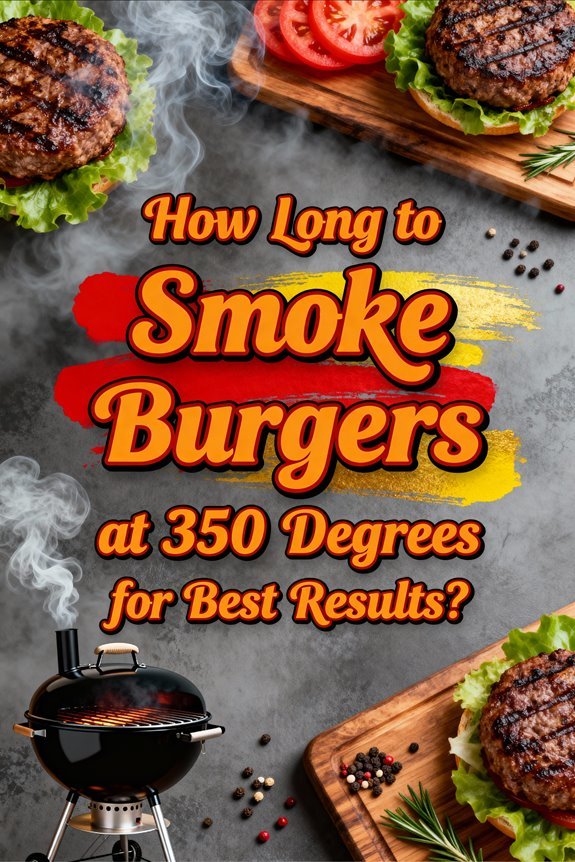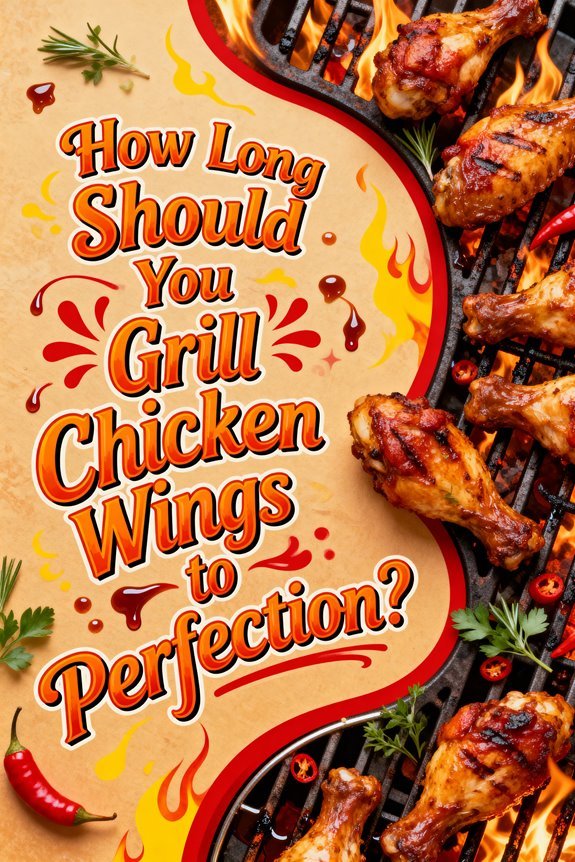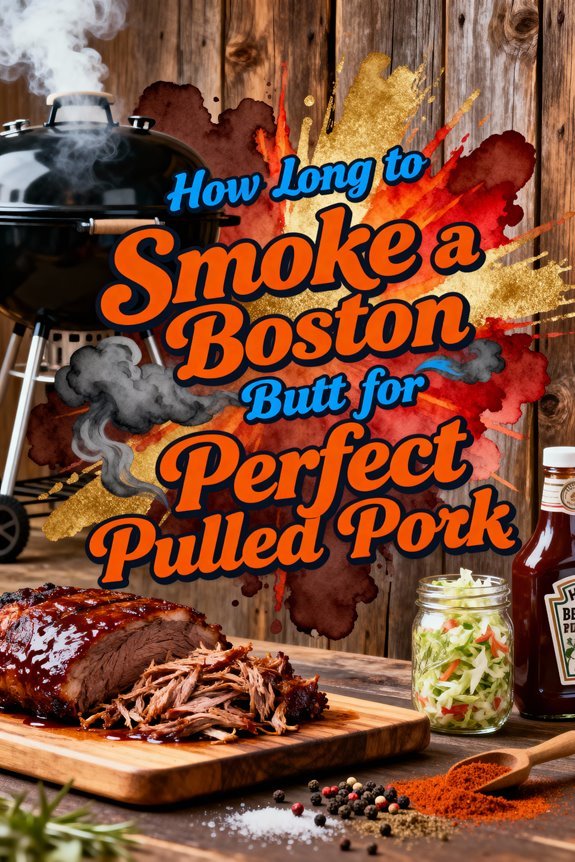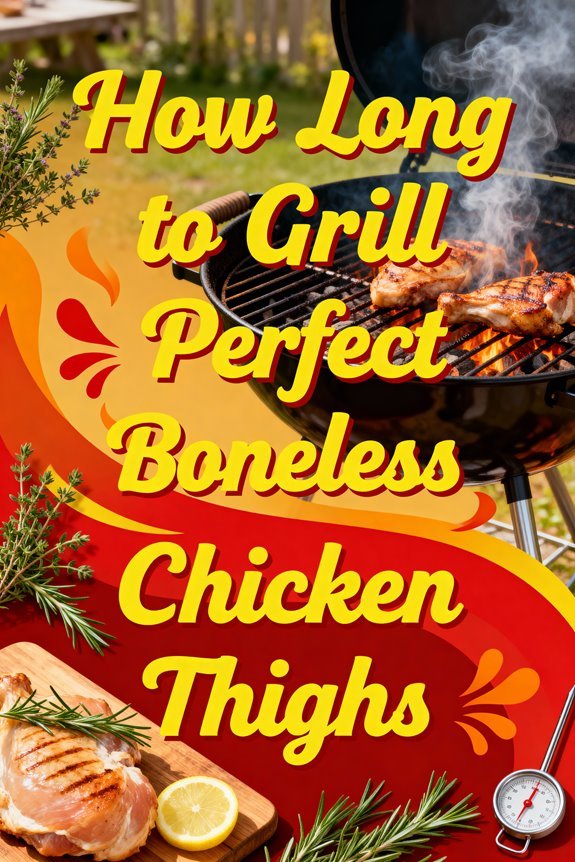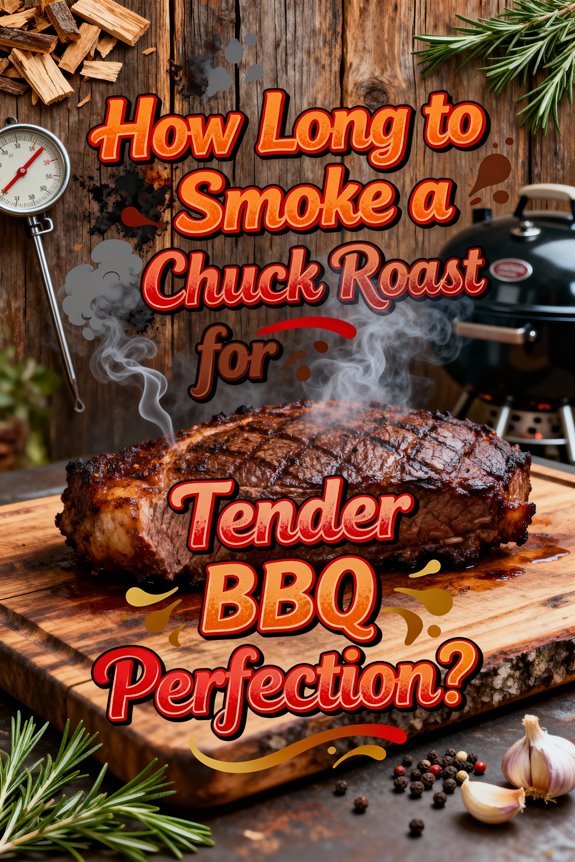You’ll need 25-35 minutes to smoke burgers at 350°F, flipping them at the 12-17 minute mark for even cooking. However, time alone doesn’t guarantee perfect results—you must verify doneness with an instant-read thermometer inserted into the thickest part of each patty. The USDA requires ground beef reach 160°F internally to eliminate harmful bacteria, regardless of color or texture. Patty thickness and fat content affect cooking duration, so temperature checks are essential. Below, you’ll uncover proven techniques for achieving consistently juicy, smoky burgers every time.
Optimal Smoking Time and Temperature Guidelines for 350°F Burgers
When smoking burgers at 350°F, you’ll need to allocate 25 to 35 minutes of total cook time to achieve proper doneness from medium-rare to well-done. Your target internal temperatures should be 130-135°F for medium-rare, 140-145°F for medium, and 150-160°F for well-done results. Flip your patties at the 12-17 minute mark to guarantee even heat distribution across both sides. Make a small thumb indentation in the center of each patty to prevent them from puffing up during cooking. Burger thickness impacts cook time, though most patties fall within this standard range when properly formed. You’ll experience faster cooking compared to traditional low-and-slow smoking techniques at 225°F, which require over an hour. Monitor internal temperature with a meat thermometer rather than relying solely on time for consistent results. Use ground beef with at least 15% fat content to ensure your burgers remain juicy and flavorful throughout the smoking process. For enhanced flavor profiles, select strong wood varieties like hickory or mesquite to achieve a deep, rich smokiness in your burgers.
Why Internal Temperature Matters More Than Cooking Time
While cooking time provides a general guideline, internal temperature serves as the definitive measure of your burger’s doneness and safety. You’ll find that cooking accuracy depends entirely on reaching 160°F internally, not adherence to time estimates. Variables like patty thickness, fat content, and smoker calibration make fixed durations unreliable. Your thermometer eliminates guesswork by providing objective data that color and timing can’t match. Similar to how smoke temperatures vary when cooking chicken wings from low to high heat, burger smoking times can fluctuate significantly. Medium-high heat on a grill typically requires 6-10 minutes total cooking time.
Ground beef requires 160°F to destroy harmful bacteria mixed throughout the patty. Smoking below this threshold risks E. coli or Salmonella exposure despite cooked appearances. Internal temperature also dictates texture—120-135°F yields juicy burgers, while exceeding targets produces dry, tough results. Weather conditions and equipment variations affect duration dramatically, but your target temperature remains constant, ensuring consistent, safe outcomes every time. For accurate readings, insert your thermometer into the thickest part of the burger to ensure you’re measuring the coolest section where bacteria may still be present.
Essential Burger Preparation Tips for Even Cooking
Understanding when your burger reaches safe temperature solves only half the equation—proper preparation determines whether that burger will cook evenly in the first place. Start with ground beef containing at least 15% fat to maintain burger juiciness during smoking. Form patties of uniform patty thickness, then create a slight indentation in each center to prevent puffing. This dimple compensates for expansion during cooking. Chill your patties for 30 minutes before smoking—cold meat holds its shape better on the grate. Handle the beef gently; overworking compacts the proteins and creates tough burgers. Season generously with dry rubs rather than wet marinades, which impede smoke absorption. Mix your ground beef with chopped sweet onion and seasonings in a bowl before forming patties to distribute flavors evenly throughout. Using a digital thermometer helps ensure your burgers reach the perfect internal temperature without guesswork. Finally, space patties evenly on clean grates to guarantee proper air circulation and consistent heat distribution throughout your smoker. For optimal safety and doneness, cook until burgers reach an internal temperature of 160°F.
Choosing the Right Wood Pellets for Maximum Flavor
The wood pellets you select will fundamentally shape your burger’s final flavor profile, making this decision as critical as choosing your meat blend. Hickory delivers robust, bacon-like smoke ideal for beef, while cherry adds mild sweetness that complements caramelized crusts at 350°F. Apple provides subtle fruitiness for lighter profiles, and pecan offers nutty richness between hickory’s boldness and fruit woods’ delicacy. Popular brands like Traeger and Pit Boss offer premium hardwood options designed specifically for smoking burgers.
Mesquite produces intense smoke—use sparingly to avoid bitterness during the 20–30 minute cook time. Wood pellet varieties perform differently: hardwoods burn steadily, releasing consistent smoke, while fruit woods contribute sweeter notes without overpowering meat flavor. Modern WiFi-enabled controllers help maintain precise temperature and smoke levels throughout the cooking process.
Consider flavor combinations like 50/50 hickory-cherry or 75/25 cherry-mesquite blends. Choose 100% hardwood pellets without bark or fillers from brands like CookinPellets, Lumber Jack, or Bear Mountain for clean-burning, pure smoke flavor. BBQers Delight blends typically combine 2/3 oak with 1/3 flavor wood for consistent high BTU output and balanced smoke characteristics.
Safety Standards and Doneness Verification Methods
Food safety isn’t negotiable when you’re smoking ground beef—the USDA and FDA both mandate a minimum internal temperature of 160°F for all burgers, regardless of personal preference. This standard eliminates harmful pathogens that proliferate in ground meat.
You’ll need an instant-read digital thermometer for accurate verification. Insert it into the thickest part of each patty, avoiding fat pockets. Don’t trust color—smoked burgers often remain pink at safe temperatures due to nitric oxide reactions from wood smoke.
Similar to smoking chicken, allowing your meat thermometer placement ensures the most accurate temperature readings throughout the cooking process. Just as with juicy chicken drumsticks, letting the thermometer rest in the thickest part without touching bone gives the most reliable reading. Proper cooking techniques require real-time monitoring. Probe thermometers with wireless alerts prevent constant smoker-opening while tracking internal temps. Clean your thermometer between readings to avoid cross-contamination. After reaching the target temperature, burgers are ready to serve immediately without requiring additional rest time.
These food safety protocols aren’t optional suggestions—they’re evidence-based standards protecting you from foodborne illness while maintaining quality results.

